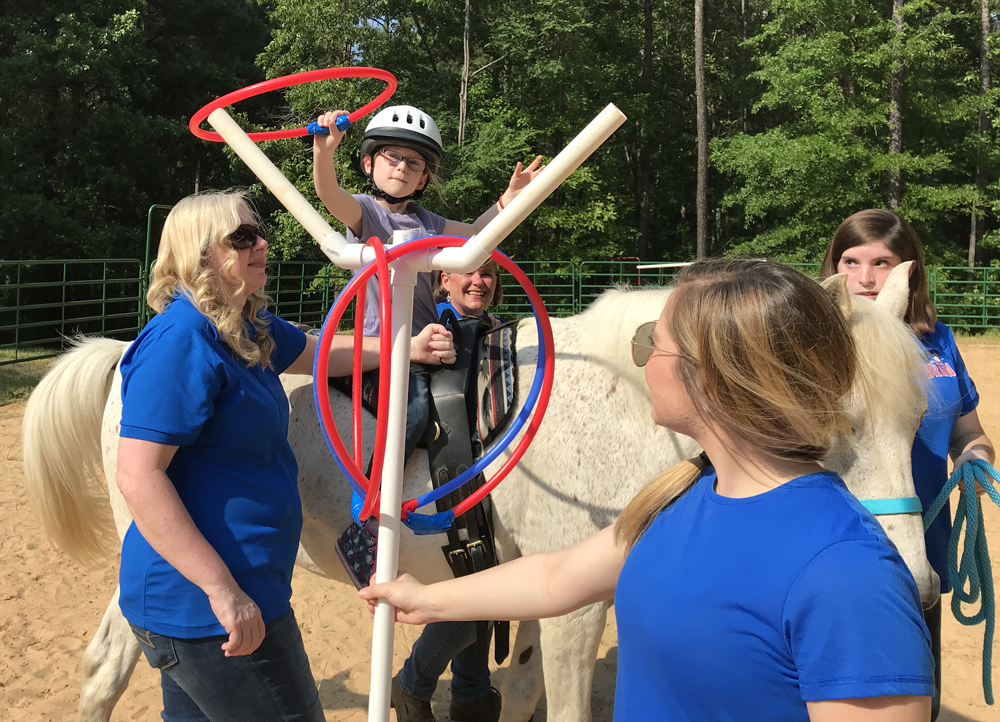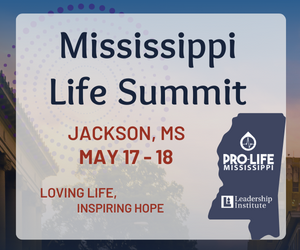By Sherry Lucas

Charlotte Allman, 7, loops a ring on the pole during an occupational therapy session with occupational therapists Kelli Colley (left) and Lisa Poe. Occupational therapy student Whitney Stokes steadies the pole and equine specialist Hope Henry leads the horse, Valdez.
Hippotherapy Offers Hope
David Miller, 9, settles onto Valdez and grips the surcingle handles with a determination that seems more cowboy than client. But, flanked by occupational therapists Lisa Poe and Kelli Colley, he’s got more riding on this than a sunny afternoon on horseback.
“Walk on, Valdez,” he repeats at Poe’s urging and, led by equine specialist Hope Henry, the horse proceeds slowly around the arena. All the while, the rhythmic movement of Valdez’s gait contributes to David’s treatment—in balance, coordination and strength for his right side weakness—as he completes tasks and rides to the front, to the side and even backward on Valdez.
Hippotherapy—use of a horse’s movements by occupational, physical, and speech therapists in treatment—is a recent extension of A Focused Brain’s Madison clinic. A Focused Brain founder/owner Lisa Poe has wanted to do the evidence-based practice for the past 25 years and has been training and building toward it for at least a decade.
“Tragedy to triumph,” Poe describes the journey. The Poes’ home and 23-acre spread near Canton are new. They lost their previous home, including beloved pets, in a house fire Nov. 4, 2016.
“We saw how God’s hand just literally picked us up and carried us for a year and a half—I mean, he still carries us every day—but, literally carried us through this whole ordeal.” She and husband, John, married nearly 28 years, had always wanted land; the loss brought an opportunity to start over. They shared their testimony and prayed over letters they sent to landowners along the Trace, with its access to riding trails. Next day, one called with, “I have exactly what you want.”
“We feel like God just orchestrated the whole thing,” Poe says. This spot, nestled between Old Natchez Trace and the Natchez Trace Parkway, is perfect for their plans. “God has opened a door for me to be here and able to do this now. I feel very blessed to implement this into our program.” She previously did hippotherapy at a barn that has since closed, and has trained extensively through the American Hippotherapy Association. Its website lists her among five trained therapists in the state using the practice
A 20-minute treatment session on the horse ideally consists of at least 2,000 steps, followed by groundwork such as brushing and petting the horse, or lifting or carrying objects, she says. “We’re engaging the sensory system, the motor system and the cognitive systems to achieve a functional task.” With clinical skills and training, therapists modify the horse’s movements to stimulate or challenge the patient, or change the patient’s position to change how the movement influences them. Therapists walk in step with the animal, arms against the child’s thighs for stability.
As David rode backward on Valdez, his hands on the horse’s rump, he received proprioceptive input—sensations from joints, muscles and connective tissue that underlie body awareness—in his fingers, wrists, elbows, shoulders, spine, and neck, sending messages to different lobes of the brain, and developing new pathways of motor learning to retrain the brain.
In the clinic, he’d get that from wheelbarrow walks, “But I did it on the horse,” Poe says. “What we do on the horse cannot be mimicked by any machine in a therapy clinic,” with tri-planar movement (front and back, side to side and rotational) of the horse’s pelvis that mirrors that of a human pelvis. David gets hip rotation, massaging his spine and sending those messages up to the brain, plus the proprioceptive movement and a host of sensory input, too, from the heat of the horse to the smell of its poop. David gets a good nose wrinkle and laugh out of that last one as they plod past the droppings.
Adopted from an orphanage in China, David has been in therapy since age 3 to treat deficits from a mild brain injury acquired before he came to the United States. “He’s a very cooperative, very determined child,” his mom, Mary Miller, says. “The Lord gave him that spirit, knowing he would need it.” With the hippotherapy sessions, “He was excited. He really likes the horses and gets to do something a little different.”
The bulk of Poe’s practice, which offers both occupational and physical therapy, involves children; she and her team have helped kids and families with attention deficit disorders, developmental delays, autism spectrum, head injuries and more. “Just the environment is what stimulates children so much,” she says of the towering trees and wooded paths, plus the motivational draw of horses. “We’re getting them out of the clinic setting, into an open environment where they can explore.”
Atop Valdez, Charlotte Allman, 7, raises both arms to strengthen her core, and loops rings on a bar to target coordination. Ella Grace Gayle, 2, helps demonstrate stations along a nature walk, reaching for colors and shapes on clips, then attaching them to Valdez’s mane. Valdez’s shorter gait works for arousal; the mule Jose, with a longer gait and heavier front step, will be useful for children with sensory deficits, who need to be calmed down, Poe says.
Her plans include having other animals on site for petting, a garden,” and more. “I have a lot of dreams for out here.”

Sherry Lucas is a freelance feature writer, copywriter and copy editor with 30-plus years of reporting and writing experience and a passion for sharing Mississippi’s cultural wealth. Email her at sherrylucas7@gmail.com.

